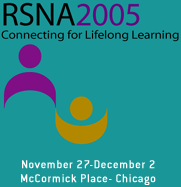
Abstract Archives of the RSNA, 2005
Carlos A Lopez, Presenter: Nothing to Disclose
Purpose/Objective: Radiation therapy for prostate cancer carries risk of side effects, mainly in the urinary, rectal and sexual domains. Regarding urinary toxicity, there is a 12-30% incidence of irritation/obstruction in these patients. Since the majority of prostate cancers arise within the peripheral zone, we hypothesized that IMRT could be used to spare portions of the proximal intraprostatic urethra, potentially minimizing urinary toxicity, while delivering a definitive dose to the peripheral zone of the prostate. Materials/Methods: Patients with low risk prostate cancer (Gleason≤6, PSA≤10, and T1c), are currently being randomized in an IRB-approved phase II trial between standard, non-urethra sparing IMRT and urethra sparing IMRT (US-IMRT). Both MRI and CT scans of the pelvis are obtained for treatment planning. Patients are ineligible if there is evidence of disease within 5 mm of the proximal prostatic urethra. In the standard IMRT plan, the planning target volume (PTV) encompasses the prostate with a 3 mm expansion. In the US-IMRT plan, the PTV consists of the prostatic peripheral zone, defined as [(prostate - transitional/central zones) + 3 mm]. Patients have gold seed fiducial markers inserted prior to obtaining the MRI, and the PTV is localized daily prior to treatment. The prescription dose to the PTV is 75.85 Gy, in 1.85 Gy per fraction. The plans are generated with our in-house inverse planning software, UMPLAN. Prospective data regarding health-related quality of life is being collected using a validated instrument (EPIC). Results: Fifty percent (7 out of 14) of the patients were found to have suspected prostate cancer within 5 mm of the proximal prostatic urethra and were excluded. The figure shows an example or the dose distribution for the US-IMRT plan. Preliminary data from seven patients (3 in the experimental arm and 4 in the standard arm) in this trial were evaluated. The mean dose to the proximal urethra was reduced by 32% with the use of US-IMRT plan. The mean dose to the proximal urethra was 52.0 Gy in the US-IMRT plan, compared to 76.2 Gy with the standard non-urethral sparing IMRT plan (p=0.037). There were no statistically significant differences in the mean doses to the bladder, rectum, penile bulb or PTV. Conclusions: US-IMRT can significantly decrease the dose to the proximal urethra without compromising PTV coverage or increasing the dose to other normal structures in the pelvis. MRI provides useful information regarding the location of prostatic lesions, excluding patients who may benefit from standard whole prostate treatment. Data to evaluate the effect of this technique on quality of life is being collected prospectively.
Lopez, C,
Early Results of a Prospective Randomized Trial Comparing Proximal Urethra Sparing IMRT and Standard Prostate IMRT in Low-Risk Prostate Cancer Patients. Radiological Society of North America 2005 Scientific Assembly and Annual Meeting, November 27 - December 2, 2005 ,Chicago IL.
http://archive.rsna.org/2005/4420799.html

